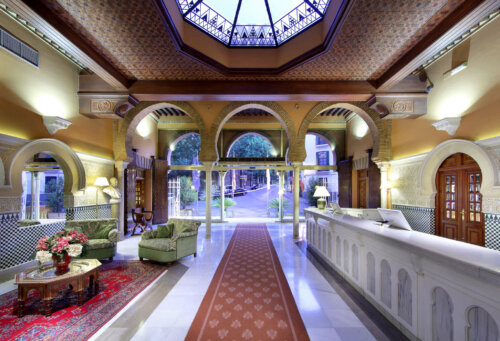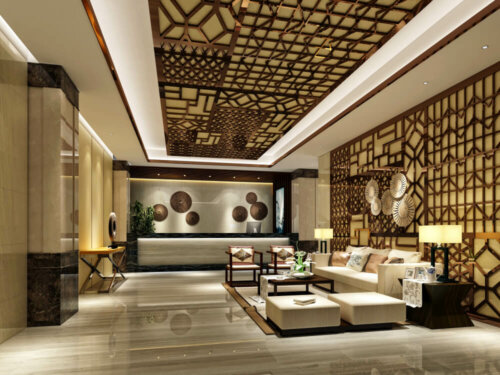How to Decorate the Common Areas of a Hotel

In the hospitality world, the hotelier must keep up standards as they work with the public and they need to uphold appearances. Hence the importance of decorating the common areas of a hotel.
Generally, corridors, waiting rooms, reception, and bedrooms must consist of accessories that show the identity of the business and are pleasing to the eye. It’s useless having a hotel without any decorative theme as it will lack identity.
The main objective is that it reflects comfort and well-being, to make guests feel at home but, also, to offer a calm and relaxed environment so people can rest.
What common areas should be worked on?

First of all, let’s be very clear about what the common areas of a hotel are. As you enter you’re in a large hall or salon where people check-in. This area usually continues to other hallways and the interior rooms.
In turn, other parts of the hotel, such as rooms where hallways meet and where the rooms are located, are places people pass through and also where the elevators usually are. We recommended all these places have a similar aesthetic.
There’s no doubt both common areas and private rooms must be in tune. In other words, if the hotel has a specific decorative theme, the aesthetics should follow this.
The decoration of the hotel must maintain uniformity
5 resources for decoration

Depending on the space you want to decorate, the type of furniture and the items should be practical, and of course, they must be of a specific appearance while keeping the aesthetic parameters.
To provide comfort it’s necessary to use armchairs and sofas. These should be in the entrance hall and also in other spacious rooms of the hotel. In any waiting area, it’s good to have a sofa at hand.
Chairs also allow people to rest. They shouldn’t be located in a specific space. Ideally, they should be distributed throughout the hotel in an orderly manner and without occupying transit spaces.
Tables are the perfect support for elements such as vases, ornaments, or other objects. They may also have lamps on them to generate non-ceiling lighting. This creates a homey environment.
Plants are a natural contribution to any interior needs. If you want to decorate with them, the freshness and greenness they give reflect comfort and a peaceful environment.
Rugs are important. Floors suffer a lot of wear since people walk on them all the time and suitcases can make the surface deteriorate. Therefore, rugs should be placed in every room, as long as they provide tone, texture, and aesthetic.
How can lighting work?

Without a doubt, lighting is an essential component that adds to the environment. It should create an alternative style that is relaxed and calm.
To promote the comfortable aesthetics of the hotel, warm lights work well, especially in the hallways. The objective is to turn the hotel into a place that reminds you of your own home.
Low lights, through floor or table lamps, can enhance the calm atmosphere. This doesn’t mean ceiling lights can’t be used. These are more functional, as long as they’re warm and not white.
In short, if you create a calm environment, this will help ensure the client’s accommodation is to their liking. This is why decorating common areas is so important, as they can help the business run smoothly.
In the hospitality world, the hotelier must keep up standards as they work with the public and they need to uphold appearances. Hence the importance of decorating the common areas of a hotel.
Generally, corridors, waiting rooms, reception, and bedrooms must consist of accessories that show the identity of the business and are pleasing to the eye. It’s useless having a hotel without any decorative theme as it will lack identity.
The main objective is that it reflects comfort and well-being, to make guests feel at home but, also, to offer a calm and relaxed environment so people can rest.
What common areas should be worked on?

First of all, let’s be very clear about what the common areas of a hotel are. As you enter you’re in a large hall or salon where people check-in. This area usually continues to other hallways and the interior rooms.
In turn, other parts of the hotel, such as rooms where hallways meet and where the rooms are located, are places people pass through and also where the elevators usually are. We recommended all these places have a similar aesthetic.
There’s no doubt both common areas and private rooms must be in tune. In other words, if the hotel has a specific decorative theme, the aesthetics should follow this.
The decoration of the hotel must maintain uniformity
5 resources for decoration

Depending on the space you want to decorate, the type of furniture and the items should be practical, and of course, they must be of a specific appearance while keeping the aesthetic parameters.
To provide comfort it’s necessary to use armchairs and sofas. These should be in the entrance hall and also in other spacious rooms of the hotel. In any waiting area, it’s good to have a sofa at hand.
Chairs also allow people to rest. They shouldn’t be located in a specific space. Ideally, they should be distributed throughout the hotel in an orderly manner and without occupying transit spaces.
Tables are the perfect support for elements such as vases, ornaments, or other objects. They may also have lamps on them to generate non-ceiling lighting. This creates a homey environment.
Plants are a natural contribution to any interior needs. If you want to decorate with them, the freshness and greenness they give reflect comfort and a peaceful environment.
Rugs are important. Floors suffer a lot of wear since people walk on them all the time and suitcases can make the surface deteriorate. Therefore, rugs should be placed in every room, as long as they provide tone, texture, and aesthetic.
How can lighting work?

Without a doubt, lighting is an essential component that adds to the environment. It should create an alternative style that is relaxed and calm.
To promote the comfortable aesthetics of the hotel, warm lights work well, especially in the hallways. The objective is to turn the hotel into a place that reminds you of your own home.
Low lights, through floor or table lamps, can enhance the calm atmosphere. This doesn’t mean ceiling lights can’t be used. These are more functional, as long as they’re warm and not white.
In short, if you create a calm environment, this will help ensure the client’s accommodation is to their liking. This is why decorating common areas is so important, as they can help the business run smoothly.
All cited sources were thoroughly reviewed by our team to ensure their quality, reliability, currency, and validity. The bibliography of this article was considered reliable and of academic or scientific accuracy.
AA. VV.: Hostelería y Turismo I, Ministerio de Educación y Ciencia, Grefol, 1994.







